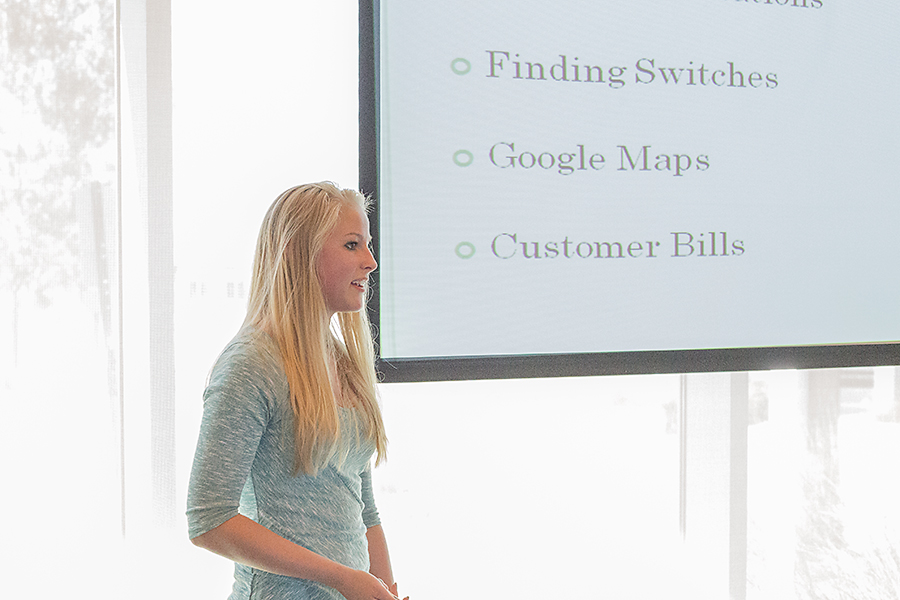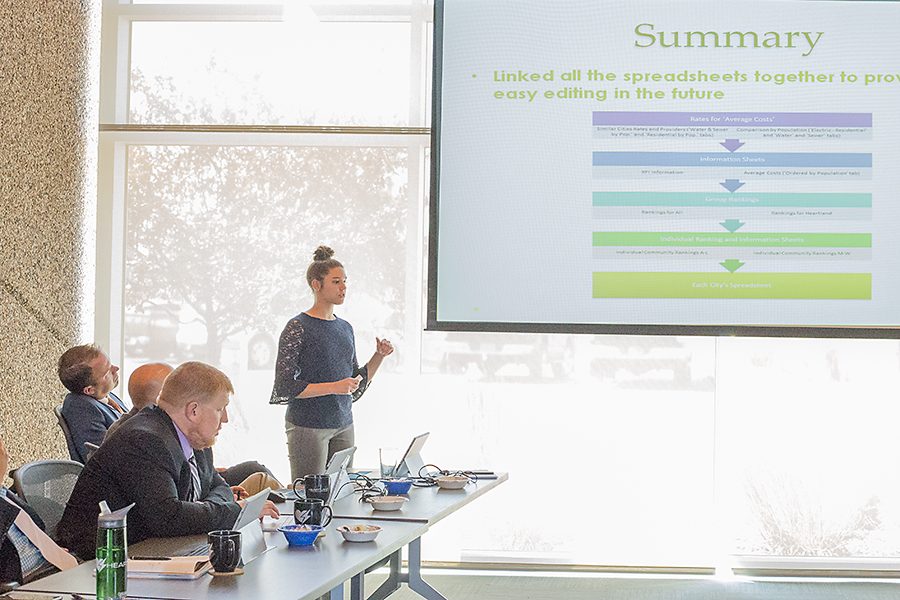Heartland interns complete projects, create resources for customers’ benefit
September 1, 2016Heartland’s two summer interns wrapped up their respective projects and presented their findings to the Heartland Board of Directors at their August meeting. Operations Engineering Intern Heather Ahlgrim and Customer Research Intern Coley Stoller each provided a detailed explanation of what they accomplished during their tenure at Heartland, their processes and how their projects will benefit our customers.

Ahlgrim tackled multiple operations projects during her internship, but the bulk of her time was spent creating and updating one-line diagrams of Heartland’s customers’ delivery points, substations and metering equipment. This process involved visiting the communities and substations to gather information first-hand, visiting with local municipal officials as well as performing extensive research utilizing diagrams from Western Area Power Administration (WAPA) and Google Maps.
“I used a lot of resources for this project,” said Ahlgrim. “The electric utility employees at each town were the most helpful–without them, this project wouldn’t have been as successful.”
Prior to Ahlgrim’s project, Heartland had one-line diagrams for many of our customers on file, but most were outdated or contained minimal details. The new diagrams are much more elaborate and include more relevant information, such as Heartland’s and the city’s points of delivery, transmission owners and voltage, switch numbers and locations, alternate sources, city substation information, meter information, distribution owners and voltage, transformer ratings, and number of feeds going into a city.
“It’s important to have updated diagrams for a number of reasons,” noted Heartland Director of Power Supply Adam Graff. “For instance, when customers are looking into a new project, their consultant may call Heartland for more information. Previously, we may not have been able to help due to our limited resources, but now we can. It’s important for the consultant and the city to know the limitations of the town’s system, and these diagrams will help determine if their current setup and equipment can handle more load. Heather did a great job putting them together.”
The other large project Ahlgrim completed involved organizing customer load data. She was asked to create a system that would allow Heartland staff to quickly find customer load data for a certain date and time as well as make comparisons between multiple data sets. She was given over 260,000 values depicting one year’s worth of hourly measurements from WAPA meters for every Heartland customer, which she organized into a custom look-up table.
“Heartland gave me a list of parameters and let me organize it how I thought best. I have never created anything of this magnitude or complexity, but it works beautifully,” she said.
Stoller’s internship involved a large amount of research as well as turning the data collected into usable, meaningful information. She was tasked with pinpointing areas of economic opportunity in Heartland’s customer communities by providing a true overall cost of doing business and cost of living. The idea was to create meaningful comparisons between customers and other communities to determine each customer’s strengths and weaknesses when it comes to growth and expansion.

Stoller spent the beginning of her internship making phone calls and performing internet searches to find rates for all of Heartland’s customers as well as approximately 50 other towns in the region. The next step was to organize the data in a manner that would be easy to manage and interpret. After collecting and compiling current electric, water and sewer rates from all the communities, she calculated the average rates and the average monthly payment for a residential customer. She also calculated average monthly payments for commercial customers based on different usage patterns.
From there, she categorized and identified strengths and weaknesses for each community using a simple ranking system. Categories ranked included rates, labor force data and tax data. Stoller also researched and documented other important information linked to community development, such as distances to major highways, local schools, and labor force and tax data.
“Based on the rankings, I was able to pick out patterns and trends in Heartland communities,” she said. “For instance, one observation I made was that towns located near or in the same county as a large university tend to have lower median ages and higher counts for people with Bachelor’s degrees. This likely means once students graduate, many of them are staying in the area. Those communities should look to capitalize on the flow of young people entering the workforce.”
The final step in Stoller’s project was developing individual profiles for each of Heartland’s customer communities, outlining her observations for each one as well as opportunities they can look to take advantage of in the future.
“Each of Heartland’s customers are unique and Coley’s research helped us identify each community’s specific attributes,” said Heartland Communications Manager Ann Hyland. “Economic development strategies are not one-size-fits-all and this information will help develop plans for growth that are specific to each city and their needs. We will be sharing this information with customers when we’re out visiting this fall.”
Heartland applied for and was awarded funding through the American Public Power Association’s DEED (Demonstration of Energy & Efficiency Developments) Program for Stoller’s internship. DEED awards scholarships to provide work experience to students at utilities and to support research projects that can be emulated by other utilities.
“Heartland was fortunate in hiring both Heather and Coley this summer,” added CEO Russell Olson. “Not only did they complete projects we’ve been wanting to accomplish for some time, they both had an amazing work ethic and were self-starters. We are proud to have given them some real-world experiences and wish them luck in all their future endeavors.”
At the completion of their internships, Ahlgrim returned to South Dakota State University in Brookings, SD to continue pursuing her degree in engineering and Stoller returned to Augustana University in Sioux Falls, SD to continue studying accounting.
